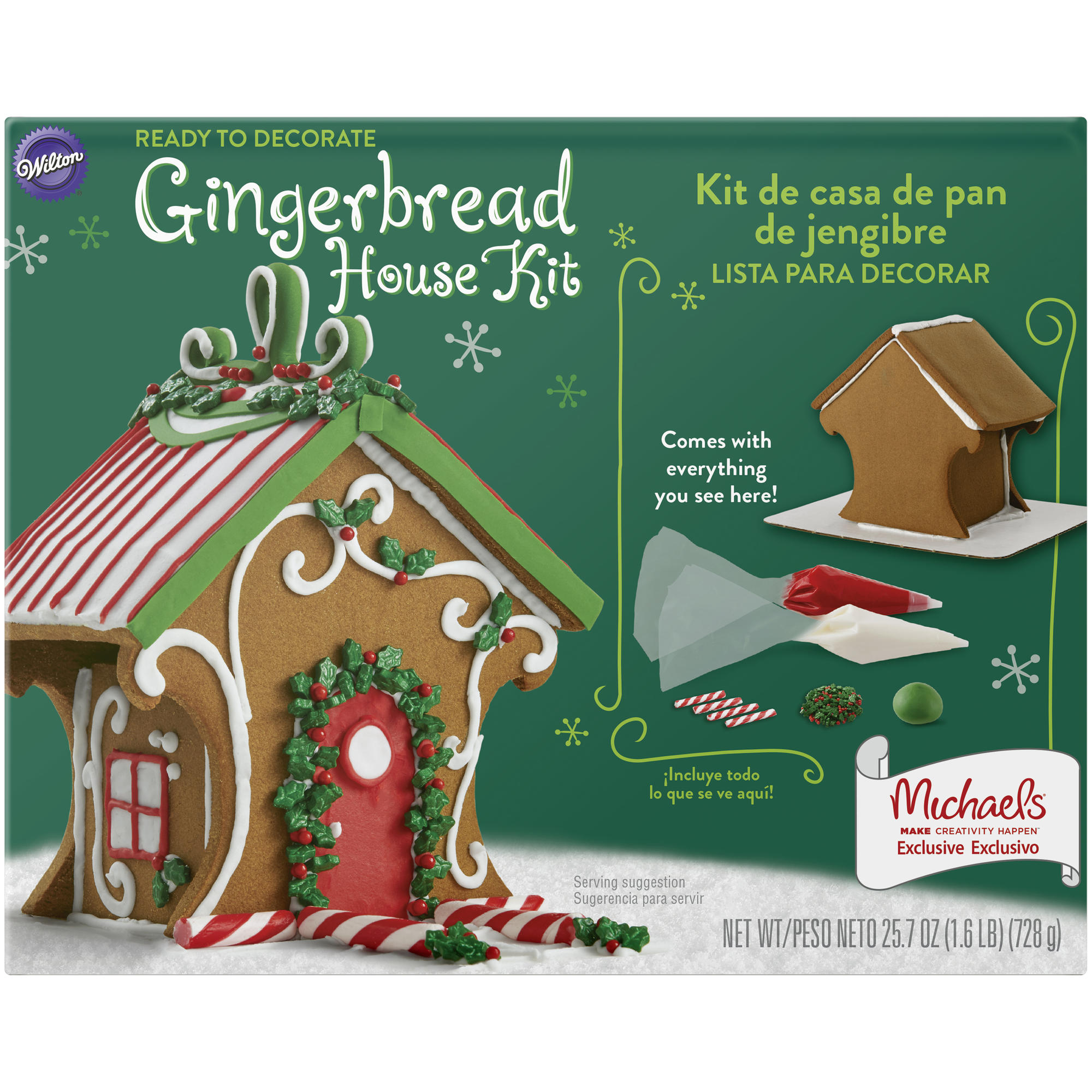For those who consider gingerbread houses and decorated gingerbread men a family affair, Michaels held its annual family "MAKE A Gingerbread House" event on Saturday, December 2nd. This is a popular event at which we decorate the pre-assembled Wilton gingerbread houses we sell in the store.
Pre-assembled gingerbread takes the time sink out of waiting for each wall to set up long enough to stay upright before trying to add the roof with correctly-angled eaves, giving families the time to add the included royal icing to trim the roof and attach little candies all over the house.
Sticking to the pre-built makes it easier, but what if you want to take it a step further?
We still sell a number of Gingerbread House kits that have all the house pieces baked, and some even embossed with guidelines for drawing windows and doors. They come with bases just big enough to hold the house, instructions, and a moderate selection of candies for trimming. (We also sell the trimmings separately.) Gingerbread House kits are also sold at some larger supermarkets, and even at some of the large drugstore chains.
Other DIY options are using (or tweaking) a recipe to make your own gingerbread and either using a set of cookie cutters that will make a Wilton-style house, or cutting out a set of patterns which can be used to cut and trim your gingerbread before it goes into the oven.
A couple of things to remember about the DIY:
- There are three different types of baked gingerbread. One is a sort of spice cake, one is an edible cookie (suitable for gingerbread men), and one is a hard (but very hunidity-sensitive) cracker used for gingerbread-house construction.
- You can probably substitute any hard cookie that doesn't crumble easily and that stands up to moisture — certain sugar cookies and ginger snaps come to mind. (The Manishevitz Chanukah House is based on a vanilla sugar cookie. The Dylan's Candy Bar house uses a chocolate cookie base.) Cookies for gingerbread "men" are not generally strong enough to use for construction.
- Remember to account for the thickness of your walls and eaves when designing and cutting your construction pieces.
- The dimensions of your cut-and-baked gingerbread pieces must be exact, or your design may not fit together correctly. You may need to trim or weight pieces immediately after baking to minimize any warp or skew.
- Not all gingerbread construction has to be a house, or even a Christmas design. Years ago, I purchased a gingerbread construction book because I was blown away by the Victorian townhouse design it included. The first gingerbread building I constructed from scratch was a Valentine-themed "Love Shack". (It wasn't pretty, but it was unique.)

- Commercially-available gingerbread-house candy trimmings change in design from year to year. Since gingerbread houses are largely for show, some old candies might be OK for trimming. Gumdrops, however, get hard — and the instructions for reviving them don't always work.
- If you're cutting gumdrops, you need a sharp knife or scissors
One of my Other Half's family traditions was his aunts' gift of a handmade ceramic church to the niece or nephew who had most recently married. It was time-consuming enough that they made only one church each year, and there was anticipation over "who would get the church this year". That aunt has since passed on, so the last time we went down for Christmas, I wanted to copy the book's gingerbread church as an homage to these two women.
I got the main building constructed and packed for a 300-mile road trip to Virginia. It made it there OK, just the roof fell off (easy to repair) and the back wall developed a crack, which I covered it with royal icing "ivy". The view you're seeing below is several hours on, when the roof decided it was at the wrong angle to attach properly to the back.
At no time did the "pediment" (the triangle that goes under the front eave and may or may not be supported by peppermint sticks) form the same angle as the church front and back, so I was never able to attach it to roof (nor was I able to find the right size peppermint sticks).
At no time did the "pediment" (the triangle that goes under the front eave and may or may not be supported by peppermint sticks) form the same angle as the church front and back, so I was never able to attach it to roof (nor was I able to find the right size peppermint sticks).
Now, this happened to be over that super hot and humid Christmas. The more I tried to fix the issues with the roof, the worse it got.
 |
Roof cracking at the back
|
  |
Things were only worse in the morning.
Having had the overnight to sit in increasingly warm humidity, instead of drying, the moisture from the royal icing seeped into the church, making the roof even less stable than it was. Rather than bring it with us, we had to let it set at the house until our noon-ish break.
We returned to sheer disaster. The heat and humidity caused the roof to cave in, one of the side walls to fall outward, and the steeple to end up in the middle of what would have been the equivalent of aisles of pews. (Good thing there were no gingerbread parishoners in there at the time!)
So... no grand entry. No nice, pretty gingerbread church. But a story that I still have fun telling.
Wishing you many years of family gingerbread stories...












No comments:
Post a Comment